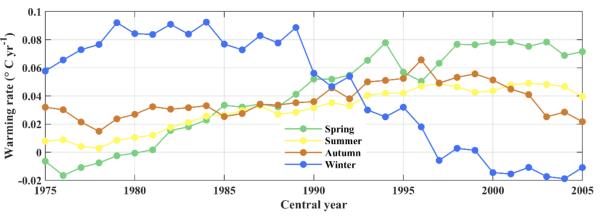The arid region of Northwest China, encompassing Xinjiang and the Hexi Corridor, has long been a focal point for climate research due to its vulnerability to climate change. The region has experienced a significant temperature increase over the past half-century.
A recent study, published in npj Climate and Atmospheric Science, revealed a dramatic shift in temperature patterns in Northwest China that the region's dominant warming season has transitioned from winter to spring since 1990s.
The study, conducted by a research team from the Xinjiang Institute of Ecology and Geography (XIEG) of the Chinese Academy of Sciences, used meteorological station data and multiple reanalysis datasets to examine temperature trends from 1960 to 2020. The results showed a clear shift in the dominant warming season around the 1990s.
This shift can be attributed to several factors, including changes in cloud cover, aerosol optical depth, and soil moisture. Researchers found a strong negative correlation between spring temperatures and cloud cover, indicating that decreased cloudiness contributed to the region's warming spring. In contrast, winter temperatures appeared less influenced by these factors.
The study also highlighted the role of the Siberian High, a large-scale atmospheric pressure system, in modulating winter temperatures. Stronger Siberian Highs have been associated with colder winters in the region, while weaker systems have led to milder conditions.
“Increased spring warming could accelerate snowmelt, potentially leading to water shortages and increased flood risks,” said SUN Fan, first author of the study.
This study has challenged previous conceptions which considered winter as the dominant warming season, and offers far-reaching implications for water resource management in Northwest China.(from XIEG)
Article link: https://www.nature.com/articles/s41612-024-00724-z

Seasonal warming rates during 1960–2020 (Image by XIEG)
